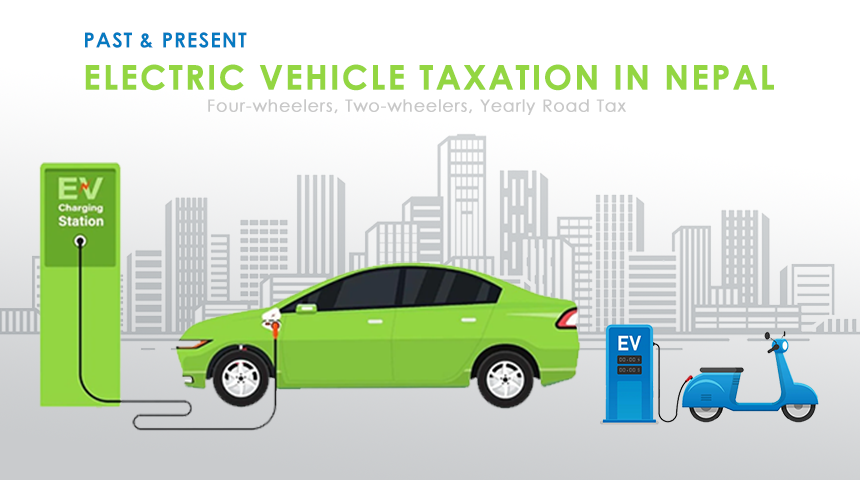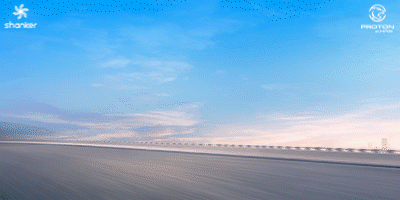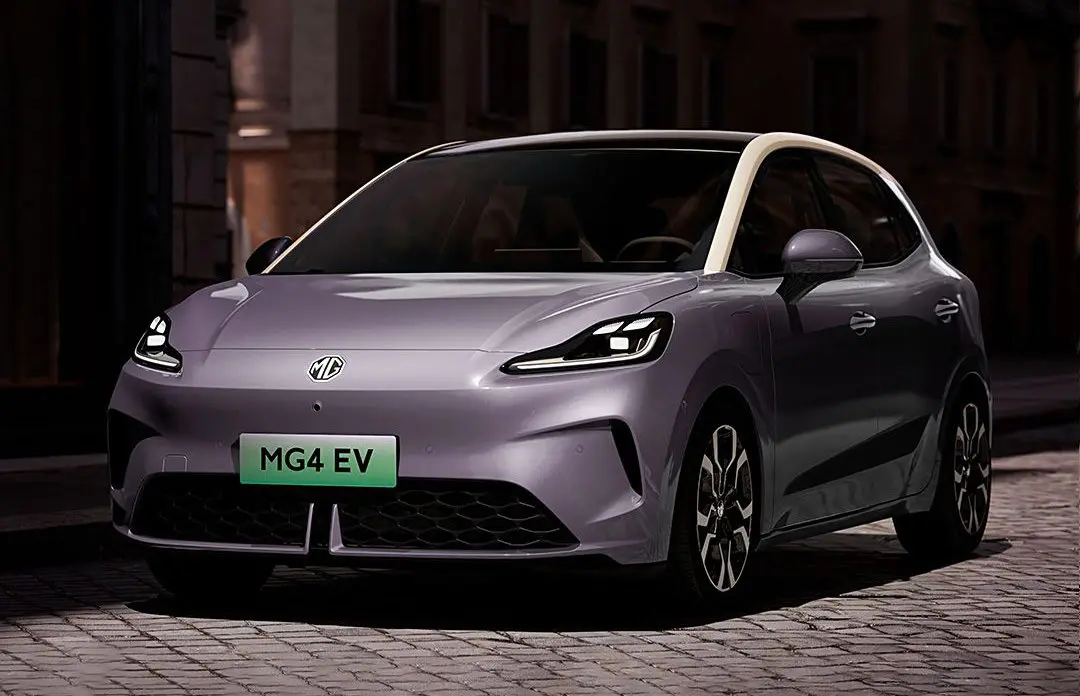HIGHLIGHTS
- The electric vehicle tax rates remain unchanged for FY 2082/83.
- Govt has introduced more incentives for EV infrastructure and assembly.
- Only 1% customs duty on EV charging station equipment.
The tax on electric vehicles for the fiscal year 2082/83 (2025-26) will remain unchanged from the previous year.

According to the Department of Customs, Nepal imported 9,859 electric four-wheelers—including cars, jeeps, and vans—in the first 10 months of the current fiscal year 2081/82 (July 2024 to May 2025). The imports are valued at NPR 23.10 billion, generating NPR 14.73 billion in customs duties. This marks a 16% increase compared to the same period last fiscal year (2080/81), when 8,497 EVs worth NPR 21.08 billion were imported.
The month of Baishakh alone saw a dramatic spike, with 1,892 EVs brought in—more than double the 878 units imported during Chaitra.
One major factor behind this accelerated adoption is the recent change in Nepal Rastra Bank’s Loan-to-Value (LTV) ratio, which reduced financing from 80% to 60%, effectively increasing the minimum down payment from 20% to 40%. This move triggered concerns over a possible future increase in EV-related taxes, prompting many buyers and importers to make early purchases and imports, respectively.
However, the recent Budget 2082/83 has further established confidence in long-term EV adoption, with goals to replace ICE imports with EVs by 2031.
To achieve this goal, Finance Minister Bishnu Paudel confirmed that the current tax structure for electric vehicles will remain unchanged.
Furthermore, the government will impose only a 1% customs duty on equipment necessary for manufacturing and assembling EV charging stations. Industries involved in this segment will also enjoy a five-year income tax exemption as part of a broader push toward electric mobility infrastructure in Nepal.
With the details out of the way, let’s dive deeper to understand the key details of the Electric Vehicle Tax Structure in Nepal for 2025/26.
Electric Vehicle Tax in Nepal
Four key taxes play a crucial role in determining its final retail price. Before diving into the breakdown, it is important to understand what these taxes are and how they influence the total cost of an electric vehicle (EV).
Here’s a closer look at each of them:
- Custom Duty: It is a tax imposed on goods (including electric vehicles) that are imported from foreign countries at the point of border entry into Nepal. It is calculated on the declared import value of the goods.
- Excise Duty: It is a tax imposed on the production, import, or sale of certain goods (including vehicles), primarily for revenue generation and regulating the consumption of luxury or environmentally impactful items. For EVs, the rate depends on motor capacity (kW).
- VAT (Value-Added Tax): It is an indirect tax applied on sales of goods and services (including vehicles) at a fixed rate of 13%. It is calculated on the total taxable amount, which includes Vehicle Cost, Customs Duty, and Excise Duty.
- RDT / RDF (Road Development Tax): It is a tax imposed during the import of vehicles to fund the development of road infrastructure in Nepal.
Four-Wheeler Electric Car Tax in Nepal
Electric vehicles (EVs) in Nepal are taxed based on their peak power output—the higher the motor capacity, the greater the customs and excise duties. In addition to these taxes, all EVs are subject to a 13% Value Added Tax (VAT), a 5% Road Development Tax (RDT), and a distributor profit margin that typically ranges from 15% to 20%.
These combined taxes and margins significantly affect the final market price of EVs in Nepal. Here is the four-wheeler electric car tax breakdown for 2082/83.
| Peak Power | Custom Duty | Excise Duty |
|---|---|---|
| 0 kW – 50 kW | 15% | 5% |
| 51 kW – 100 kW | 20% | 15% |
| 101kW – 200kW | 30% | 20% |
| 201kW – 300kW | 60% | 35% |
| 301kW – above | 80% | 50% |
*VAT = 13%, RDT = 5%, Distributor Profit: 15-20%
Four-Wheeler EV Tax Rates Trends in the Last Five Years
The electric vehicle (EV) tax structure in Nepal has undergone significant changes from the fiscal year 2078/79 to 2082/83.
Initially, EVs with lower motor power outputs—particularly those up to 100 kW—enjoyed minimal customs duties and zero excise duties, making them highly affordable and encouraging early adoption. However, as the adoption of EVs increased, the government revised its taxation strategy.
As of the FY 2082/83, customs duties now range from 15% to 80%, and excise duties vary from 5% to 50%, depending on the vehicle’s peak power output. Despite these changes, the Value Added Tax (VAT) remains at 13%, and the Road Development Tax (RDT) is consistently set at 5% across all fiscal years.
The following table highlights the change in tax duties representing Custom Duty / Excise Duty from the fiscal year 2078/79 to 2082/83.
| Power (kW) | FY 2078/79 | FY 2079/80 | FY 2080/81 | FY 2081/82 & FY 2082/83 |
|---|---|---|---|---|
| 0 kW – 50 kW | - | - | - | 15% / 5% |
| 51 kW – 100 kW | 10% / 0% | 10% / 0% | 15% / 10% | 20% / 15% |
| 101 kW – 200 kW | 15% / 0% | 30% / 30% | 20% / 20% | 30% / 20% |
| 201 kW – 300 kW | 30% / 0% | 45% / 45% | 40% / 45% | 60% / 35% |
| 301 kW and Above | 40% / 0% | 60% / 60% | 60% / 60% | 80% / 50% |
*VAT = 13% and RDT = 5% has remained unchanged
Four-Wheeler Electric Vehicle Yearly Road Tax
The four-wheeler electric vehicle (EV) owners must pay an annual road tax in Nepal. This yearly tax is based on the peak power capacity of the motor and is classified into four categories across different price ranges.
Here is the four-wheeler electric vehicle yearly road tax breakdown for 2082/83.
| Peak Power | Yearly Tax |
|---|---|
| 10 kW – 50 kW | Rs. 5000 |
| 51 kW – 125 kW | Rs. 15000 |
| 126 kW – 225 kW | Rs. 20000 |
| 226 kW – above | Rs. 30000 |
Two-Wheeler Electric Tax in Nepal
Interestingly, electric two-wheelers in Nepal have not gained the same traction as their four-wheeled counterparts. MeroAuto article indicates that out of approximately 125,000 two-wheelers sold annually, only around 3,750 units—or just 3%—are electric.
This modest adoption persists despite the introduction of over 74 electric two-wheeler brands since 2019. Notably, more than two dozen of these brands have already exited the market.
Due to this limited market penetration and slower adoption rate, government taxation policies for electric two-wheelers have remained largely unchanged since 2078/79, lacking the aggressive revisions seen in the four-wheeler EV sector.
In Nepal, the taxes on two-wheeler electric vehicles include a 10% customs duty, a 13% Value Added Tax (VAT), and a Road Development Tax (RDT) of NPR 10,000. Additionally, there is a distributor profit margin that usually ranges from 15% to 20%.
| Peak Power | Custom Duty | Excise Duty |
|---|---|---|
| 250W – above | 10% | 0% |
*VAT = 13%, RDT = Rs. 10,000, Distributor Profit: 15-20%
Two-Wheeler Yearly Electric Vehicle Road Tax
The two-wheeler electric vehicle (EV) owners must also pay an annual road tax. This yearly tax is based on the peak power capacity of the motor and is classified into five categories across different price ranges.
Here is the two-wheeler electric vehicle yearly road tax breakdown for 2082/83.
| Peak Power | Yearly Tax |
|---|---|
| Up to 50W | Rs. 1000 |
| 51W – 350W | Rs. 1500 |
| 351W – 1000W | Rs. 2000 |
| 1001W – 1500W | Rs. 2500 |
| 1501W – above | Rs. 3000 |
Conclusion on Electric Vehicle Tax Rate in Nepal
The FY 2082/83 budget has renewed confidence in Nepal’s EV sector. The government is not only maintaining its progressive tax policies but is also actively implementing bold measures to accelerate the country’s transition to clean transportation.
The electric four-wheeler segment is experiencing rapid growth driven by increased consumer interest and sustained government support. Due to this, the long-term outlook remains positive due to ongoing tax incentives and infrastructure development outlined in the current budget.
With a balanced approach that includes infrastructure development, incentives, and industrial policies, Nepal is paving the way for a cleaner, more sustainable era of mobility.
What do you think about the latest Budget 2082/83? Share your thoughts in the comments down below!
-
MG4 Urban Coming to Nepal in 2026: When a Mohawk Cut Grows UpHIGHLIGHTS MG4 Urban price in Nepal will sit in the range of Rs. 40 to…
-
POCO F7 to Arrive in Nepal Alongside Other POCO Phones?HIGHLIGHTS The Poco F7 price in Nepal could start at Rs. 52,999 (12/256GB). It features…
-
Price Hike Alert: Ai+ Pulse & Nova 5G Price Increases by Rs. 1,000HIGHLIGHTS The Ai+ Pulse and Nova price in Nepal start from Rs. 9,999 (4/64GB) and…














